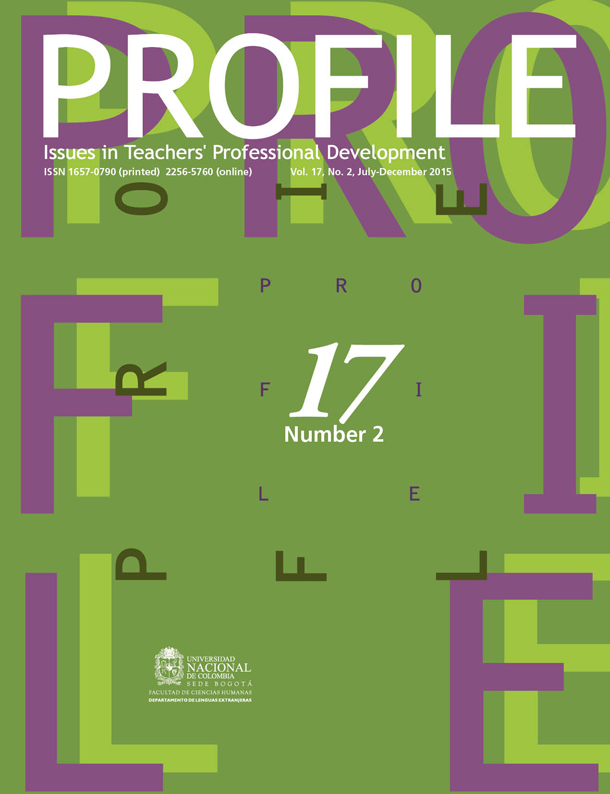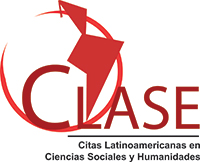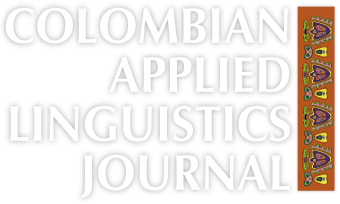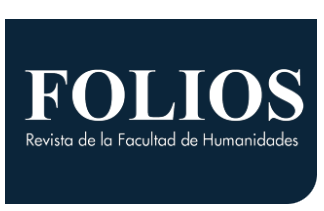Students’ Perceptions of the Impact of CLIL in a Mexican BA Program
Percepciones de los estudiantes sobre el impacto de la enseñanza de contenido-lengua integrados en un programa de pregrado en México
DOI:
https://doi.org/10.15446/profile.v17n2.47065Keywords:
Content and language integrated learning, material development, Mexican context, students’ perceptions, tertiary bilingual education (en)Contexto mexicano, diseño de materiales, educación superior bilingüe, enseñanza de contenido-lengua integrados, percepciones de los estudiantes (es)
Content and language integrated learning is an innovative pedagogical approach used in educational institutions worldwide. This study considers information and experiences from various settings in order to explore content and language integrated learning within the Mexican context. This study reports the perceptions of students in a BA program. Through the study’s using qualitative research, the students’ voices students reveal their emotions, struggles, benefits, and opinions related to taking content and language integrated learning classes. The analysis of the participants’ information shows the potential for implementing content and language integrated learning programs in Mexico in that it suggests some areas of improvement for teachers, material design, administrators, and institutions in general.
El enfoque pedagógico de enseñanza de contenido-lengua integrados es una tendencia innovadora en los sistemas educativos del mundo. El estudio se basa en la información y experiencia de varios contextos donde se ha usado este enfoque para explorarlo en el contexto mexicano. El artículo reporta las percepciones de estudiantes de licenciatura para conocer más sobre la enseñanza de contenido-lengua integrados. A través de la investigación cualitativa, las voces de los estudiantes revelarán las emociones, dificultades, ventajas y opiniones al tomar clases con este enfoque. El análisis de datos muestra el potencial de la implementación de programas de enseñanza de contenido-lengua integrados en México, mientras sugiere áreas de oportunidad para docentes, diseño de materiales, administrativos e instituciones en general.
https://doi.org/10.15446/profile.v17n2.47065
Students’ Perceptions of the Impact of CLIL in a Mexican BA Program
Percepciones de los estudiantes sobre el impacto de la enseñanza de contenido-lengua integrados en un programa de pregrado en México
Alejandra Nuñez Asomoza*
Universidad Autónoma de Zacatecas, Zacatecas, Mexico
This article was received on November 4, 2014, and accepted on January 30, 2015.
How to cite this article (APA 6th ed.):
Nuñez Asomoza, A. (2015). Students’ perceptions of the impact of CLIL in a Mexican BA program. PROFILE Issues in Teachers’ Professional Development, 17(2), 111-124. https://doi.org/10.15446/profile.v17n2.47065.
This is an Open Access article distributed under the terms of the Creative Commons license Attribution-NonCommercial-NoDerivatives 4.0 International License. Consultation is possible at http://creativecommons.org/licenses/by-nc-nd/4.0/.
Content and language integrated learning is an innovative pedagogical approach used in educational institutions worldwide. This study considers information and experiences from various settings in order to explore content and language integrated learning within the Mexican context. This study reports the perceptions of students in a BA program. Through the study’s using qualitative research, the students’ voices students reveal their emotions, struggles, benefits, and opinions related to taking content and language integrated learning classes. The analysis of the participants’ information shows the potential for implementing content and language integrated learning programs in Mexico in that it suggests some areas of improvement for teachers, material design, administrators, and institutions in general.
Key words: Content and language integrated learning, material development, Mexican context, students’ perceptions, tertiary bilingual education.
El enfoque pedagógico de enseñanza de contenido-lengua integrados es una tendencia innovadora en los sistemas educativos del mundo. El estudio se basa en la información y experiencia de varios contextos donde se ha usado este enfoque para explorarlo en el contexto mexicano. El artículo reporta las percepciones de estudiantes de licenciatura para conocer más sobre la enseñanza de contenido-lengua integrados. A través de la investigación cualitativa, las voces de los estudiantes revelarán las emociones, dificultades, ventajas y opiniones al tomar clases con este enfoque. El análisis de datos muestra el potencial de la implementación de programas de enseñanza de contenido-lengua integrados en México, mientras sugiere áreas de oportunidad para docentes, diseño de materiales, administrativos e instituciones en general.
Palabras clave: contexto mexicano, diseño de materiales, educación superior bilingüe, enseñanza de contenido-lengua integrados, percepciones de los estudiantes.
Introduction
There are two main objectives for this study, the first being to give a voice to students pursuing their BA in foreign languages (Licenciatura en Lenguas Extranjeras, LILEX) at Universidad Autónoma de Zacatecas (UAZ) to express their perceptions about the content and language integrated learning (CLIL) classes they are currently offered in the program. The second objective is to offer valuable information to other students, teachers, school administrators, and Mexican institutions in general on the potential of implementing CLIL classes in tertiary education. By listening to students’ perceptions, I intend to draw a detailed picture that describes their experiences in terms of their opinions, challenges, strategies, and feelings when receiving content classes in a foreign language, English.
Based on the students’ perceptions as presented in the present study, I offer proposals that could aid in improving the program considering particular features such as the contents, materials, teacher training, and class methodology. I hope this information will positively impact how English classes are perceived across UAZ. Hopefully, the data will also serve as a starting point for additional research about CLIL in order to understand how this phenomenon works in Mexico and how teachers, students, and society in general can benefit from it in this particular context.
Context of the Study
The foreign language BA program at UAZ in Northeast Mexico opened in August 2011, after ten years of curriculum planning and design. The program lasts four years, and students are offered three majors in the field of applied linguistics: teaching, translation, or enterprise-services assistant. One of the main innovations of this program is that along with the variety of subjects that students take, they are required to take a foreign language (L3) of their choice, which could be German, French, or Italian. All subjects (except the L3) in the first three semesters are taught in Spanish, and when students start the fourth semester, all of the core subjects (except the L3) are taught in English. Students’ English language competence is monitored every semester by their taking a TOEFL sample test, on which they should increase their score by 30 points each time.
In terms of the program’s teaching staff, they must also fulfill particular requirements in order to be hired. In general, teachers are expected to have at least an undergraduate degree in linguistics, teaching, or any other area depending on the subject they will teach. They must also have an English level equivalent to C1 according to the Common European Framework of Reference for Languages (CEFRL), and they should preferably have at least a B1 (CEFRL) level in any other foreign language.
Literature Review
This section provides a collection of terms and definitions that serve as frames of reference for the study.
Education and Language Policies
Education and how it is implemented in different contexts has been closely related to the particular linguistic features of the agents and participants who take part in the education processes in different domains. The inclusion of languages (especially English) in schools’ curricula has gained great importance over the last years. Seidlhofer (2011) notes how English as a lingua franca “is spreading in various and varied manifestations and adapted to the needs of intercultural communication” (p. 17) in different contexts. Therefore, its consolidation has been imminent in response to the communication needs of individuals around the world. Governments from nearly every country have been faced with the fact that implementing English language teaching in schools is very important if they want to be immersed into and keep up with the rapid flow of information and communication with their counterparts around the world.
Considering the work and studies being conducted regarding not only bilingual but also multilingual education in different parts of the world (Costa & D’Angelo, 2011; Lorenzo, Casal, & Moore, 2010), it can be said that this is a trend that has proven to be successful in different contexts. It shows great potential to address some of the major issues in education systems worldwide in terms of language, and it also offers solutions in this area.
Defining CLIL
Countries and institutions that have implemented the use of foreign or second languages in their education systems and curricula have worked with an innovative pedagogical approach that has come to be known in recent years as CLIL. According to Coyle, Hood, and Marsh (2010), “[CLIL] is a dual-focused educational approach in which an additional language is used for the learning and teaching of both content and language” (p. 1). Thus, it is important to emphasize that the attention that is given within a classroom to both language and content should be balanced because CLIL “is an innovative fusion of both” (Coyle et al., 2010, p. 1). It is because of this duality and potential flexibility, which characterizes CLIL, that it is conceived as an integral approach. Therefore, Graddol (as cited in Coyle et al., 2010) describes it as the “ultimate communicative methodology” (p. 5). It was claimed that the main feature that set CLIL above the most popular communicative methods known in the 1990s was the “the high level of authenticity” (Coyle et al., 2010, p. 5) that could be reached through it.
CLIL in Tertiary Education
Costa (2009) explains how “studies on CLIL . . . have continued to increase in terms of its outcomes in primary and secondary schools, but there is still a lack of research at the tertiary level” (p. 85). Although research is still limited in regard to CLIL as it is implemented or perceived in universities, there have been important efforts to identify the phenomena present in this context, and there is in fact increasing interest in the matter. Costa (2009) mentions that because of the rapid change in the academic trends in schools around the world, students and teachers face a reality in which knowledge is mostly accessible to those who speak English because it is considered the lingua franca of today. Recently, European countries have made remarkable progress regarding the implementation of CLIL in their universities, and they are viewed as models for institutions in other parts of the globe where this approach has been recently and slowly entering tertiary-level education.
CLIL in Mexico
Unlike European countries that have developed and implemented clear linguistic policies for their education models and other instances of their government structures (Coleman, 2006; Dalton-Puffer, 2011; Lorenzo, 2007), Mexican authorities have only recently acknowledged learning English as a foreign language (EFL) as a policy that must be officially implemented in schools (Davies, 2009). Related to this occurrence, Maza (2012) observes how Mexico has faced important problems in this area because of the lack of human resources—teachers who are professionals in the field of EFL.
Even though efforts are being made to support EFL in this country, there is still a long way to go before English teachers and the Mexican educational system in general are able to accomplish what has been accomplished so far elsewhere, especially in European countries, in implementing CLIL. This comparison, according to Davies (2009), “is relevant because Mexican public ELT is increasingly modeled on the CEF [Council of Europe Framework]” (p. 10). Therefore, it is highly possible that some tertiary education institutions in Mexico are working on designing or operating CLIL programs because this pedagogical approach has been proven to be successful in other parts of the world.
Method
Research Questions
To explore the issues participants face regarding using CLIL at this stage of their learning process, the following research questions were proposed: (1) What are students’ perceptions about CLIL courses in the BA in foreign languages program? (2) What are the major challenges students face in CLIL courses, and what are the strategies they use (if any) to help themselves reach their learning objectives? (3) What are students’ perceptions regarding the benefits of taking CLIL classes?
Qualitative Research
According to Gonzalez (as cited in Cohen, Manion, & Morrison, 2011), “qualitative research provides an in-depth, intricate, and detailed understanding of meanings, actions, non-observable as well as observable phenomena, attitudes, inten-tions, and behaviours” (p. 219). All of these features that are inherent to qualitative research were found to be useful and efficient for exploring and explaining the study’s findings. Merriam (2009) states that “qualitative researchers are interested in understanding how people interpret their experiences, how they construct their worlds, and what meaning they attribute to their experiences” (p. 5). Given that qualitative research focuses specifically on portraying participants’ perceptions in order to understand their experiences with CLIL, the research questions were designed in such a way that the potential answers would describe in detail the participants’ visions about the issues discussed.
In addition, Dörnyei (2007) highlights that “qualitative research is very helpful in deciding what aspects of the data require special attention because it offers priority guidelines that are valid by the main actors themselves” (p. 39). Given this important feature of qualitative research, classifying the participants’ data was more practical because some of the main topics had already been identified or noted by the study participants.
Research Participants
The study required volunteers in their fifth semester. After they learned the study details and how it would be conducted, a total of 11 students volunteered to participate, six women and five men. Before the data collection process began, all participants were asked to sign a letter of consent, and additional information about the study and its procedures was provided.
Data Collection Instruments and Procedures
Data for the research were gathered using semi-structured interviews “in which the researcher uses a written list of questions as a guide, while still having the freedom to digress and probe more information” (Mackey & Gass, 2005, p. 173). Additionally, semi-structured interviews, according to McDonough and McDonough (1997), “allow for greater flexibility . . . for example in changing the order of the questions and for more extensive follow-up responses” (p. 183). It was thought that the instrument’s flexibility would also allow participants to perceive the task as less stressful, and this would encourage them to provide useful and more authentic information.
Once the interview guidelines were produced in accordance with the research questions, the data collection process began by agreeing on individual interview schedules proposed by the students within a time frame set up by the researcher. Before participants were interviewed, they were made aware of the procedures and ethical policies and the protocol to be followed in the task. Because participants had different levels of English or Spanish proficiency, they were asked to choose whether they wanted to be interviewed in either English or Spanish. This option was provided to ensure the comfort of the participants so they could express themselves freely and without linguistic obstacles.1
Results and Discussion
Derived from the data analysis, the following sections present the information about the students’ perceptions regarding various aspects of the CLIL courses.
Perceptions About CLIL
During the interviews, participants were asked to describe their feelings about having to take content classes in English. Figure 1 shows a scale that contains the information expressed by the participants. The emotions and feelings that had positive connotations are grouped on the left side of the scale, and those with a negative connotation are placed on the right.
As shown in Figure 1, there was a balance between the participants’ positive and negative emotions in terms of quantity given that the number of positive and negative categories is the same. This feature is also interestingly mirrored in the way students expressed their ideas during the interviews. The majority of the answers had both positive and negative elements, which can be observed in the following examples: “I felt excited, but at the same time, I was fearful” (Sara) and, “I was happy and nervous at the same time” (Gerardo). It is worth mentioning that the emotions and feelings expressed by the participants did not vary greatly despite the fact that their levels of language command differed. Although for the majority of students who defined themselves as native speakers of English (NSE), emotions were mainly positive, as observed in the quotes “I was pretty excited!” (Regina) and “I felt happy and less anxious” (Gisela), participants still reported having a sense of uncertainty about what CLIL classes would be like.
In addition to the emotions and feelings that the students could identify, other factors played an important role in how the students perceived this educational model. Mehisto, Marsh, and Frigols (2008) observe that the teachers and the material design are two of the most important elements for working successfully with the CLIL approach. Considering this, participants were questioned about their initial perceptions of their teachers and classmates and the materials in the CLIL classes. Table 1 presents the answers regarding the three elements that were previously mentioned, and a detailed analysis and discussion about them follow in the next sections.
Perceptions About Teachers
Teachers are regarded as one of the main elements within a classroom, and in the case of this study, the role of teachers is crucial to how the approach is perceived by students. It is worth noting that presently, all of the CLIL teachers working at LILEX are native speakers of Spanish. Before taking classes in English, the students had interacted with the same lecturers in Spanish only, and thus, knowing that these same teachers would begin to speak English inside the classroom caused curiosity in most of the students in a variety of aspects. For example, one of the participants stated:
I noticed that in regards to the teachers’ pronunciation, I was surprised! I was used to something else, so it was a weird change . . . it was weird because I expected it to be like back there [in the United States] . . . I expected perfect pronunciation, and I saw it wasn’t like that. . . . But then one realizes that pronunciation is the least important; what really matters is the content. (Maira)
Pronunciation is one of the main aspects of language that speakers perceive during an interaction, and it is to be expected that students would consider this feature to be important in CLIL classrooms. In regard to learning a language or learning through a language, students and teachers have certain beliefs about pronunciation and accents. Many of these beliefs could originate mainly from previous experiences or interactions with speakers of the target language, or they could simply emerge from expectations about what language pronunciation should be like.
As shown in Table 1, the participants who were interviewed consisted of both NSEs and NNSEs. Students self-identified during the interviews as members of either group despite the fact that even among them, the English proficiency differed. To define themselves as members of either group, participants considered a variety of aspects, resulting in the expression of different ideas. For instance, when asked about her identity as an NSE or NNSE, one of the participants specified:
I’m a native speaker of Spanish because I was born here [in Mexico]. From when I was born until I was eleven years old, I was here. However, I’m a native speaker of English, but in the academic aspect . . . when I speak Spanish is something very colloquial. In fact, that’s something I want to change a little, but my English is more academic; I can easily use a different level of language. (Maira)
The previous self-definition of this participant clearly considers her different skills in both languages, and this feature can make this particular student a member of both groups under different circumstances. However, because of this identity that participants share, and because of their high language proficiency in general, NSEs’ perceptions of the CLIL teachers’ English pronunciation in terms of accent was different than those of the NNSEs, which was noted in the first quote in this section. Lippi-Green (1997) notes that “when a native speaker of a language other than English acquires English, accent is used to refer to the breakthrough of native language phonology into the target language” (p. 43). Taking into account the participants’ perceptions of the teachers’ accents, the teachers’ language proficiency was questioned in some cases, as can be observed in the following quote:
I would say that half the teachers were well prepared, overqualified even. I would say: “They have a very good level of English, and they make their classes interesting; it looks like we’re learning.” Some teachers who didn’t seem to have good training have surprised me! They have helped me a lot. (Javier)
The participants’ perceptions about the teachers’ language proficiency are similar to those found by Aguilar and Rodríguez (2012). In their study, some of the students were concerned about the fact that their teachers were not NSEs, but they reported overall satisfactory perceptions of the CLIL classes in relation to how the teachers spoke the language of instruction and the class in general. As can be observed in the previous quote, in the end, the participants’ perceptions about this aspect of the CLIL class at LILEX can be categorized as positive.
Perceptions About Classmates
Within a classroom, students engage in interactions not only with the teacher but also with their classmates. This is possibly one of the most significant experiences for students in that they share various encounters with each other. Regarding their perceptions of their classmates, the participants made revealing statements. It was in this aspect that the separation of the NSE and NNSE groups was clearly defined. The following quote by an NSE participant illustrates the situation:
I saw a lot of tension because in the first semesters, when it was like pure Spanish, I remember that Gisela and I used to struggle a lot! And our classmates obviously saw that...and we were like: “Oh come on help us,” . . . and everybody was like: “Oh no, I know and you don’t.” And now that it’s in English, the ones who were above, now they’re below, and some of them ask me for help, and I’m like, “Oh yeah, I’ll help you.” . . . That’s the tension. And most of them, they feel very frustrated in English. (Regina)
In contrast, an NNSE participant reported the following observation:
Those who come from or have lived in the United States are the ones who come mainly from small towns. They come back and group together, and sometimes they isolate us or we isolate ourselves. It’s like one always finds a group to fit in. (Roxana)
From the quotes above, it is evident that participants perceive differences among them, and they describe them according to their group memberships. These distinctions made by participants themselves evidently had an impact on the environment in the CLIL classroom.
Participants reported how the classroom environment changed once the courses began being taught in English. The class dynamic changed, identities were redefined or questioned, and all of this led to attitudes that turned negative in some cases:
About my classmates, I saw an attitude of shock because some of them are non-native speakers and some of us (two or three) are native speakers or close . . . and I saw a change in them, a decrease in their academic performance. That makes one feel bad because I used to be one of the weak students, and now . . . they’re below . . . I feel like their self-esteem went down, and their behavior towards us is very strong. It’s like they say: “You can speak better than me.” (Gisela)
The implications of these changes are quite relevant to how students learn through CLIL. Mehisto et al. (2008) state that “CLIL classes work to create life experiences and at the same time to tap the innate language learning ability we all had as young children and adolescents” (p. 32). In this study, the NSEs experienced the CLIL approach when they began taking classes in Spanish during the first three semesters of the major, whereas for the NNSEs, the process began in the fourth semester. It is very interesting to see how even when both groups had the experience of working with CLIL in different stages of their learning processes, their reactions towards each group were similar and yet had different outcomes. When NNSEs had the advantage of speaking Spanish, they were reported as not helping the NSEs, but when the language of instruction changed to English, the NNSEs were able to receive help from NSEs. This particular phenomenon cannot be generalized to all students taking CLIL classes in this program, or for that matter, any other program. This behavior could just be perceived as a characteristic of this particular cohort. Thus, it would be advisable to consider the presence of interactions of this type in other CLIL groups in order to reach a final conclusion about how different categories of speakers might react in CLIL environments at school.
Perceptions About Materials
The last aspect the participants evaluated was material design. Overall, the participants had positive perceptions of the materials in that they found them to be appropriate in terms of language and content. The following quote exemplifies this idea:
[Materials] were appropriate; I found them understandable. I even expected a higher level, something more difficult for me to understand, but it was the opposite. I started reading, and I saw that I could understand the texts. They were appropriate for our level, and I stopped being nervous. (Gerardo)
From the quote above, it can be interpreted that after having contact with the materials in the CLIL classes, the students were able to reduce their anxiety about not being able to follow the class or the readings given by their teachers. By having a positive first experience with the materials, participants managed to build new perceptions of the classes and the target language. According to Coyle et al. (2010), materials, in addition to teachers and students, are essential in a CLIL classroom because they are linked to motivation and anxiety, two significant factors in the process of language learning. The fact that students feel that they are able to work with materials allows them to feel confident, and they can therefore concentrate on other aspects of the learning process: “I receive [the content] without worrying about not understanding; instead, I can concentrate on the subject” (Maira).
In addition to having a positive perception of the materials in the CLIL classes, the participants recognized another important aspect related to the courses and the tools used in them. They were able to identify genres and vocabulary that were completely new to them in English, as is highlighted in the following statement:
For example, linguistics is something very different. It’s not just learning grammar because there are texts about other topics that are very different from those that one is used to reading.” (Ramiro)
Identifying academic genres is one of the main features of CLIL, and it is also considered one of the most important skills that CLIL students should develop. Therefore, these findings derived from the participants’ observations coincide with the research analysis of CLIL genres by Llinares, Morton, and Whittaker (2012). They emphasize the importance of recognizing the types of texts and discourses that are to be found in CLIL classes. In doing so, teachers can design materials that prepare students to manage different genres successfully, and the class dynamic will change in favor of students. If students are in fact already on the path of acknowledging CLIL genres, as was expressed in their answers to the questions, then the actual work with them would be expected to become more efficient.
Challenges Faced in CLIL Courses
In response to the question “What has been the most challenging aspect you have faced in the English content classes?”, nearly all students responded that academic writing was the main difficulty they had encountered: “Writing [has been difficult] because I didn’t have much practice. I hardly ever wrote in English, so I have had to practice” (Leo). Another participant noted the problems he had had with academic writing and the possible reasons for that:
Writing is difficult, especially essays. I think the reason is that I have lowered my reading rhythm. Before, I used to read more and I wrote better, I mean back in the United States, and now that I came back [to Mexico], I find obstacles to keep reading. (Javier)
As was mentioned earlier, students discovered new genres within the CLIL classes that made it challenging for them to keep up with the class content and the tasks. Earlier, it was also mentioned how teachers are responsible for the usage and design of materials that help students gain a better sense of the genres they need to be familiar with in a CLIL classroom. However, other factors influence students’ perceptions of the difficulty level of the CLIL class.
In this sense, another participant mentions, “Speaking has been the most difficult. . . . Fear takes over me, and I block; I forget all the words; it’s horrible!” (Roxana). In regard to these aspects that participants perceived as difficulties, Davies (2009) notes that one of the major challenges for English students in Mexico is that “they are not offered the English they are more likely to need, for medicine, engineering, business administration, and so on” (p. 14). Therefore, the participants’ previous expressions appear to be plausible given that their knowledge until they began the formal CLIL classes was mostly general rather than academic, even in the case of some NSEs.
Another challenging aspect that was reported by participants is “the grammar, because here in Mexico, they focus too much on grammar structures” (Gisela). Students are generally concerned about this feature of language because knowledge of English grammar has been traditionally highly valued in Mexico. This perception coincides with what Maza (2012) identifies as one of the main disadvantages for implementing CLIL in Mexico, which relates to balancing acquiring and understanding content at the students’ language proficiency levels. From the quote by Gisela, it can be interpreted that the focus on language form is still present and plays an important role in the CLIL classes students currently receive at LILEX.
In addition to the previous concern expressed by the participants, there was a reference to their difficulties in increasing their TOEFL scores. As was mentioned earlier, the program requires students to take a sample test to measure their language proficiency each semester. However, participants have faced problems in regards to performing this activity:
On the TOEFL, I haven’t been able to increase my score. On the contrary, I lowered my score for a long time and now I think I’m exactly like I was when I decreased. That causes me uncertainty that I can’t...I mean, I’m sure I know more than when I started the major. (Ramiro)
According to Vency and Ramganesh (2013), the TOEFL is one of the most popular instruments used by institutions worldwide to help them measure their students’ language proficiency. Considering this, there should be a direct relationship between students’ performance in the CLIL classes and their results on the TOEFL exam. The fact that the participants’ perceptions of their performance on this test were negative can be linked to the other issues they identified as problematic in the CLIL classes, such as academic writing and reading.
Participants are in fact perceiving an increase in their language command and what they can do and achieve while performing various tasks within the CLIL classroom. However, Van de Craen, Mondt, Allain, and Gao (2007) report that for the case of young learners, “if, however the learning of reading and writing takes place in the first language, the learner’s most important language for academic achievement remains the first language” (p. 71). Although the previous findings are mostly applicable to students between 9 and 10 years old according to Van de Craen et al., it could be that some of the NNSE students in this CLIL program experienced difficulties in this area because they had not fully developed academic skills in English, whereas NSEs who went to school in an English-speaking country did build these academic skills to a higher level.
However, Van de Craen et al. (2007) note that for older students, “results seem to depend much more on individual variation, teacher characteristics, and intra- and interpersonal variation and abilities” (p. 72). Considering all of the previous information, it would be worth working especially with NNSEs or weak NSEs (students who came back to Mexico still as young learners) to help them develop their cognitive, academic, and linguistic skills in general. Because these students are only in the first year of the CLIL experience, they would still have the time to improve, and they would be able to see progress in their daily academic performance as well as in less frequent but compulsory activities, such as taking the TOEFL exam.
Benefits About CLIL Classes
Table 2 shows the results of the perceptions expressed by the participants as advantages or disadvantages in taking CLIL classes at LILEX.
Interestingly, the items that the participants reported as being disadvantages correspond to a certain extent to most of the challenges they encountered in the CLIL classes. As mentioned previously, the items that participants perceived as difficulties or challenges were related to their academic skills and development within the CLIL classroom. However, there are two salient items in this group of what participants perceived as disadvantages: (1) not having a strong foundation in Spanish and (2) their Mexican pride was crushed.
The first item reported by participants is relevant because it reflects a well-known linguistic fact that is a link between knowledge of the L1 (mother tongue) and learning the L2 (Agustín Llach, 2009). As Agustín Llach (2009) notes, there is still controversy in determining whether the influence of the L1 is positive or negative in acquiring the L2. However, the fact that the participants mention this particular issue as something that concerns them is important to be considered at least in regard to the affective elements that impact how they learn the second language through CLIL classes:
I think that we should have a specific class in Spanish...writing maybe. We should take it as something extra, because sometimes one focuses on English, but we don’t know Spanish...so, how’s that possible? (Ramiro)
From the quote above, it can be interpreted that students are probably looking to their L1 to find something close to what they are doing in the L2 in terms of academic skills. Although the writing systems in English and Spanish are different (Crawford, 2010), students might possibly feel closer to or more familiar with the academic genres if they knew them well in Spanish first. In a study conducted by Aguilar and Rodríguez (2012), there is reference to the fact that students suggested including some sort of translation into their L1 as part of their interactions with teachers in the CLIL classroom. This finding could provide evidence that students enrolled in CLIL classes could consider it helpful to be able to access some information in the L1.
The second item relates to participants’ self-identifying as being native or non-native speakers of English. This issue was observed to influence the interactions of both groups within the CLIL classroom, and it is also linked to students’ perceptions of the language used as the medium of instruction at this stage of their education process:
It is a disadvantage [to use English] in terms of pride, but it is an advantage because it helps us increase the level of students, and this prepares us for a different type of context. It’s not just learning English as a language but as something that we use in other contexts. (Maira)
Despite the fact that some of the participants could perceive their Mexican pride as being threatened by the usage of a language such as English, they did perceive the benefits and advantages they would have by learning this language: “The focus of the major is that [learning English], so it obviously has to happen...we have to do it” (Leo) and “This is as it should be, because if this is what we are focusing on, then classes have to be taught in English” (Ramiro). It is observable that students are aware that this is a step they have to take in their learning process, and they know that it is something they will eventually need to see as natural.
Because of this awareness about having to use English in their content classes, the students also see advantages in the CLIL approach. According to Table 2, most of the items identified as advantages related to developing academic skills and practicing the language. In this sense, one of the participants voiced the following idea about the advantages she has perceived:
This is a great opportunity to be bilingual and then trilingual...it is awesome because besides learning the language, one also learns the culture and many concepts that simply...A common speaker would just have a “normal” conversation . . . but, for example, they can’t talk about linguistics or teaching. (Sara)
Some of the advantages are perceived by various participants as being disadvantages at the same time and vice versa. However, according to their expressions, this serves as a sort of motivation that encourages students to continue working on improving themselves in academic aspects in general.
Participants’ Suggestions for the CLIL Classroom
Regarding future CLIL students (groups in the first and third semesters), the participants recommended prior preparation and practicing skills such as speaking or reading in the target language (English). Based on their experiences in over a year of working with the CLIL approach in the program, the participants stated that having prior preparation in the language and reviewing the core concepts (subject content) they had seen in previous semesters would have allowed them to feel more confident when they began the CLIL classes.
It was also noted that the teacher’s role is very important, especially in CLIL classrooms. Students’ suggestions for the CLIL teachers included improving the methodology and material design, introducing assignments in English in earlier semesters, empathizing with students, and extra tutoring. The students suggested promoting coordinated work with students, teachers, and administrators to learn about what happens inside CLIL classrooms, support student projects and improve facilities and material access.
Conclusions
From the research conducted in this study, important information has been revealed. This study’s findings will undoubtedly serve as a basis for implementing other CLIL programs at UAZ and at other universities across this country. Based on these findings and considering the research questions, it can be concluded that:
- Students have an overall positive perception of the CLIL courses offered in the BA in foreign languages at UAZ that sets an optimistic premise for the successful implementation of other CLIL programs at this institution and at other Mexican universities. However, participants identify many areas that could be improved in regard to teachers, classmates, materials, and the environment in general.
- Students in the CLIL program at LILEX struggle mainly with developing academic skills such as academic writing, identifying and using academic genres, and vocabulary. Students have not used any particular strategies to improve these aspects, although they are aware of their weaknesses and possible ways to overcome them.
- Students perceive the benefits of taking CLIL classes by being able to use the language in a different context and improving their academic skills. However, they would like to have deeper knowledge of the Spanish language. Although they feel positive about learning school contents in English, some of them are concerned about this language threatening their Mexican pride.
In addition to the above, and considering the findings of the study, it is advisable that the BA in foreign languages program and potential CLIL programs to be offered at UAZ or other tertiary education institutions in Mexico consider the following ideas:
- Training the teachers through international certifications that guarantee advanced command of the English language. Although the latest research in the field of world English (Crystal, 2003; Jenkins, 2009) debates the idea of using standardized exams (e.g., IELTS, TOEFL) to measure a person’s linguistic competence, these exams are still acceptable ways to keep teachers updated and prepared to a certain extent until new instruments or trends are released.
- Training teachers in methodology for CLIL classes and material design. In addition to having advanced knowledge of the language of instruction, teachers also need to be current on ways of delivering both content and language (Hillyard, 2011). Having expertise in teaching strategies, methods of assessment, and material design would give teachers more tools to provide students with what they need in order to acquire deeper knowledge about their major and other areas of interest to them.
- Training and updating teachers about current issues in their areas of specialization, preferably in English so they can have deeper knowledge of the content and language they teach in the CLIL classroom. As mentioned previously, it is important that teachers be in constant training, not only to know more about what they do and what they teach inside the classroom but also so they can place themselves in students’ shoes. Doing so would sensitize teachers and lead them to be empathic with their learners, thereby strengthening the affective aspects of language learning.
- Careful design of the CLIL curricula so that the approach is implemented at least in the main subjects of the program beginning in earlier semesters. Operating a CLIL program is complex because many factors and aspects must be considered. Thus, constant revisions of how the program is working and implementing action research about the situations related to operating a program of this type would allow for reflections and actions regarding the appropriateness of starting CLIL instruction earlier in a BA program.
- Including workshops or multidisciplinary training for English and content teachers in order for students to develop general and specific academic skills. Collaborative work among language and content teachers would easily allow for enriching and improving the CLIL syllabus, and having teachers as models of cooperative work would undoubtedly positively impact the environment so that students could leave behind issues of division and discrimination within the school domain, thus translating into tolerant behavior outside of school.
- Promoting campaigns by students, teachers, and administrators in which English is appreciated as a global (Crystal, 2003) language that allows for intercultural communication and knowledge exchange. Gaining knowledge and fostering reflection on the new trends of language policies worldwide would help students contextualize the type of education they are receiving. This would also sensitize learners, teachers, and administrators to be more tolerant of and open to debates and reflection about languages and education issues in general.
Recommendations for Future Research
This study is the first of its type to be conducted at LILEX and at UAZ, and therefore, there are a number of areas for research that could be exploited in order to increase the knowledge about the CLIL phenomenon at the micro and macro levels. These recommendations for further research could include the following ideas: (a) contrasting students’ perceptions about the CLIL courses at LILEX with the perceptions of the CLIL teachers, (b) studying the perceptions about native speakers of English (Mexican-American students) working with the CLIL approach in Mexico, and (c) studying the effects of CLIL classes on students’ performance on the TOEFL exam.
1As part of the ethical policies, interviewees were assigned pseudonyms in order to protect their identities. It is also important to mention that ten of the eleven participants asked to be interviewed in Spanish, and therefore, the extracts presented throughout the article were translated into English by the researcher. Regina’s interview was completely carried out in English.
References
Aguilar, M., & Rodríguez, R. (2012). Lecturer and student perceptions on CLIL at a Spanish university. International Journal of Bilingual Education and Bilingualism, 15(2), 183-197. https://doi.org/10.1080/13670050.2011.615906.
Agustín Llach, M. (2009). The role of Spanish L1 in the vocabulary use of CLIL and non-CLIL EFL learners. In Y. Ruiz de Zarobe & R. M. Jiménez Catalán (Eds.), Content and language integrated learning: Evidence from research in Europe (pp. 112-129). Bristol, UK: Multilingual Matters.
Cohen, L., Manion, L., & Morrison, K. (2011). Research methods in education. Oxon, UK: Routledge.
Coleman, J. (2006). English-medium teaching in European higher education. Language Teaching, 39(1), 1-14. https://doi.org/10.1017/S026144480600320X.
Costa, F. (2009). ICLHE/CLIL at the tertiary level of education: State-of the art. Studies About Languages (Kalbu Studijos), 15, 85-88.
Costa, F., & D’Angelo, L. (2011). CLIL: A suit for all seasons? Latin American Journal of Content & Language Integrated Learning, 4(1), 1-13. https://doi.org/10.5294/laclil.2011.4.1.1.
Coyle, D., Hood, P., & Marsh, D. (2010). CLIL: Content language integrated learning. Cambridge, UK: Cambridge University Press.
Crawford, T. (2010). ESL writing in the University of Guanajuato: The struggle to enter a discourse community. Guanajuato, MX: Universidad de Guanajuato.
Crystal, D. (2003). English as a global language. Cambridge, UK: Cambridge University Press. https://doi.org/10.1017/CBO9780511486999.
Dalton-Puffer, C. (2011). Content-and-language integrated learning: From practice to principles? Annual Review of Applied Linguistics, 31, 182-204. https://doi.org/10.1017/S0267190511000092.
Davies, P. (2009). Strategic management of ELT in public educational systems: Trying to reduce failure, increase success. TESL-EJ, 13(3), 1-22.
Dörnyei, Z. (2007). Research methods in applied linguistics: Quantitative, qualitative, and mixed methodologies. Oxford, UK: Oxford University Press.
Hillyard, S. (2011). First steps in CLIL: Training the teachers. Latin American Journal of Content & Language Integrated Learning, 4(2), 1-12.
Jenkins, J. (2009). World Englishes: A resource book for students. Oxon, UK: Routledge.
Lippi-Green, R. (1997). English with an accent: Language, ideology and discrimination in the United States. London, UK: Routledge.
Llinares, A., Morton, T., & Whittaker, R. (2012). The roles of language in CLIL. Cambridge, UK: Cambridge University Press.
Lorenzo, F. (2007). The sociolinguistics of CLIL: Language planning and language change in 21st century Europe. Revista Española de Lingüística Aplicada, 20, 27-38.
Lorenzo, F., Casal, S., & Moore, P. (2010). The effects of content and language integrated learning in European education: Key findings from the Andalusian bilingual sections evaluation project. Applied Linguistics, 31(3), 418-442. https://doi.org/10.1093/applin/amp041.
Mackey, A., & Gass, S. M. (2005). Second language research: Methodology and design. New Jersey, NJ: Routledge.
Maza, M. A. (2012). Content and language integrated learning: advantages and disadvantages. TLATEMOANI Revista Académica de Investigación, 9, 1-11.
McDonough, J., & McDonough, S. (1997). Research methods for English language teachers. London, UK: Hodder Education.
Mehisto, P., Marsh, D., & Frigols, M. J. (2008). Uncovering CLIL: Content language integrated learning in bilingual and multilingual education. Oxford, UK: Macmillan Education.
Merriam, S. B. (2009). Qualitative research: A guide to design and implementation. San Francisco, CA: John Wiley & Sons.
Seidlhofer, B. (2011). Understanding English as a lingua franca. Oxford, UK: Oxford University Press.
Van de Craen, P., Mondt, K., Allain, L., & Gao, Y. (2007). Why and how CLIL works: An outline for a CLIL theory. Views, 16(3) 70-78.
Vency, H. J., & Ramganesh, E. (2013). Is language proficiency taken care of at higher education level? Need for self-efficacy of post graduate students. Journal of Language Teaching and Research, 4(6), 1176-1183. https://doi.org/10.4304/jltr.4.6.1176-1183.
About the Author
Alejandra Nuñez Asomoza holds a BA in TESOL by the University of Guanajuato (Mexico). She works at the Universidad Autónoma de Zacatecas (Mexico), where she is a teacher trainer and teaches linguistics. In 2014, she was awarded the degree of MA in English language teaching with distinction by the University of Southampton (UK).
References
Aguilar, M., & Rodríguez, R. (2012). Lecturer and student perceptions on CLIL at a Spanish university. International Journal of Bilingual Education and Bilingualism, 15(2), 183-197. https://doi.org/10.1080/13670050.2011.615906
Agustín Llach, M. (2009). The role of Spanish L1 in the vocabulary use of CLIL and non-CLIL EFL learners. In Y. Ruiz de Zarobe & R. M. Jiménez Catalán (Eds.), Content and language integrated learning: Evidence from research in Europe (pp. 112-129). Bristol, UK: Multilingual Matters.
Cohen, L., Manion, L., & Morrison, K. (2011). Research methods in education. Oxon, UK: Routledge.
Coleman, J. (2006). English-medium teaching in European higher education. Language Teaching, 39(1), 1-14. https://doi.org/10.1017/S026144480600320X
Costa, F. (2009). ICLHE/CLIL at the tertiary level of education: State-of the art. Studies About Languages (Kalbu Studijos), 15, 85-88.
Costa, F., & D’Angelo, L. (2011). CLIL: A suit for all seasons? Latin American Journal of Content & Language Integrated Learning, 4(1), 1-13. https://doi.org/10.5294/laclil.2011.4.1.1
Coyle, D., Hood, P., & Marsh, D. (2010). CLIL: Content language integrated learning. Cambridge, UK: Cambridge University Press.
Crawford, T. (2010). ESL writing in the University of Guanajuato: The struggle to enter a discourse community. Guanajuato, MX: Universidad de Guanajuato.
Crystal, D. (2003). English as a global language. Cambridge, UK: Cambridge University Press. https://doi.org/10.1017/CBO9780511486999
Dalton-Puffer, C. (2011). Content-and-language integrated learning: From practice to principles? Annual Review of Applied Linguistics, 31, 182-204. https://doi.org/10.1017/S0267190511000092
Davies, P. (2009). Strategic management of ELT in public educational systems: Trying to reduce failure, increase success. TESL-EJ, 13(3), 1-22.
Dörnyei, Z. (2007). Research methods in applied linguistics: Quantitative, qualitative, and mixed methodologies. Oxford, UK: Oxford University Press.
Hillyard, S. (2011). First steps in CLIL: Training the teachers. Latin American Journal of Content & Language Integrated Learning, 4(2), 1-12.
Jenkins, J. (2009). World Englishes: A resource book for students. Oxon, UK: Routledge.
Lippi-Green, R. (1997). English with an accent: Language, ideology and discrimination in the United States. London, UK: Routledge.
Llinares, A., Morton, T., & Whittaker, R. (2012). The roles of language in CLIL. Cambridge, UK: Cambridge University Press.
Lorenzo, F. (2007). The sociolinguistics of CLIL: Language planning and language change in 21st century Europe. Revista Española de Lingüística Aplicada, 20, 27-38.
Lorenzo, F., Casal, S., & Moore, P. (2010). The effects of content and language integrated learning in European education: Key findings from the Andalusian bilingual sections evaluation project. Applied Linguistics, 31(3), 418-442. https://doi.org/10.1093/applin/amp041
Mackey, A., & Gass, S. M. (2005). Second language research: Methodology and design. New Jersey, NJ: Routledge.
Maza, M. A. (2012). Content and language integrated learning: advantages and disadvantages. TLATEMOANI Revista Académica de Investigación, 9, 1-11.
McDonough, J., & McDonough, S. (1997). Research methods for English language teachers. London, UK: Hodder Education.
Mehisto, P., Marsh, D., & Frigols, M. J. (2008). Uncovering CLIL: Content language integrated learning in bilingual and multilingual education. Oxford, UK: Macmillan Education.
Merriam, S. B. (2009). Qualitative research: A guide to design and implementation. San Francisco, CA: John Wiley & Sons.
Seidlhofer, B. (2011). Understanding English as a lingua franca. Oxford, UK: Oxford University Press.
Van de Craen, P., Mondt, K., Allain, L., & Gao, Y. (2007). Why and how CLIL works: An outline for a CLIL theory. Views, 16(3) 70-78.
Vency, H. J., & Ramganesh, E. (2013). Is language proficiency taken care of at higher education level? Need for self-efficacy of post graduate students. Journal of Language Teaching and Research, 4(6), 1176-1183. https://doi.org/10.4304/jltr.4.6.1176-1183
How to Cite
APA
ACM
ACS
ABNT
Chicago
Harvard
IEEE
MLA
Turabian
Vancouver
Download Citation
CrossRef Cited-by
1. Francesca Zanoni. (2021). Students’ View on CLIL: Perceived Benefits and Limitations . EL.LE, (2) https://doi.org/10.30687/ELLE/2280-6792/2021/02/005.
2. Tammy Mercedes Fajardo Dack, Juanita Argudo, Mónica Abad. (2020). Language and Teaching Methodology Features of CLIL in University Classrooms: A Research Synthesis. Colombian Applied Linguistics Journal, 22(1), p.40. https://doi.org/10.14483/22487085.13878.
3. Juanita Argudo, Mónica Abad, Tammy Fajardo-Dack, Patricio Cabrera. (2018). Analyzing a Pre-Service EFL Program through the Lenses of the CLIL Approach at the University of Cuenca-Ecuador. Latin American Journal of Content & Language Integrated Learning, 11(1), p.65. https://doi.org/10.5294/laclil.2018.11.1.4.
4. Jeesson Stiven Contreras Avendaño, Alejandro Malaver Duarte, Juan Esteban Morales Vargas, Judith Castellanos Jaimes. (2024). Retos de la enseñanza del inglés: el caso de un colegio público. Enunciación, 29(2), p.253. https://doi.org/10.14483/22486798.21435.
5. Hao Hao, Masanori Yamada. (2021). Review of Research on Content and Language Integrated Learning Classes from the Perspective of the First Principles of Instruction. Information and Technology in Education and Learning, 1(1), p.Rvw-p001. https://doi.org/10.12937/itel.1.1.Rvw.p001.
Dimensions
PlumX
Article abstract page views
Downloads
License

This work is licensed under a Creative Commons Attribution-NonCommercial-NoDerivatives 4.0 International License.
You are authorized to copy and redistribute the material in any medium or format as long as you give appropriate credit to the authors of the articles and to Profile: Issues in Teachers' Professional Development as original source of publication. The use of the material for commercial purposes is not allowed. If you remix, transform, or build upon the material, you may not distribute the modified material.
Authors retain the intellectual property of their manuscripts with the following restriction: first publication is granted to Profile: Issues in Teachers' Professional Development.















































